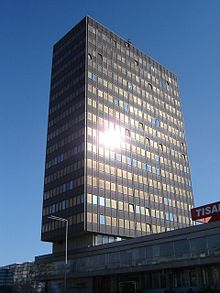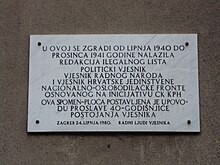Our website is made possible by displaying online advertisements to our visitors.
Please consider supporting us by disabling your ad blocker.
Vjesnik
 | |
 The Vjesnik building in Zagreb | |
| Type | Daily newspaper |
|---|---|
| Format | Berliner |
| Publisher | Vjesnik d.d. (1946–2008)[1] Narodne novine d.d. (2008–2010)[2] Tiskara Vjesnik (2010–2012)[2] |
| Founded | 24 June 1940 |
| Language | Croatian |
| Ceased publication | 20 April 2012[3] (print) July 2012 (online) |
| Headquarters | Slavonska avenija 4, Zagreb, Croatia |
| ISSN | 0350-3305 |
| Website | www |

Vjesnik (lit. 'courier') was a Croatian state-owned daily newspaper published in Zagreb. Originally established in 1940 as a wartime illegal publication of the Communist Party of Croatia, it later built and maintained a reputation as Croatia's newspaper of record during most of its post-war history. It ceased publication in April 2012.[3] "Tiskara Vjesnik" and "Vjesnik d.d." were the namesakes of the Vjesnik's printing office and publishing house, respectively.
During World War II and the Nazi-allied Independent State of Croatia regime which controlled the country, the paper served as the primary media publication of the Yugoslav Partisans movement. The August 1941 edition of the paper featured the statement "Smrt fašizmu, sloboda narodu" (transl. Death to fascism, freedom to the people) on the cover, which was afterwards accepted as the official slogan of the entire resistance movement and was often quoted in post-war Yugoslavia.
Its heyday was between 1952 and 1977 when its Wednesday edition (Vjesnik u srijedu or VUS) regularly achieved circulations of 100,000 and was widely read across Yugoslavia.[4] From late 1974 the publishing house ran a subsidiary office in Frankfurt in West Germany which published the edition of 5,000-10,000 copies targeted at numerous Yugoslav workers ('gastarbeiter') and other citizens living in the country.[5]
Following Croatia's independence and the breakup of Yugoslavia in the early 1990s its circulation steadily began to dwindle, as Vjesnik came under the control of the Croatian Democratic Union (HDZ), at the time the ruling conservative party. Ever since the 1990s, Vjesnik was seen as always taking a pro-government editorial stance, and it even changed its name briefly in 1992 to Novi Vjesnik in an attempt to distance itself from its own communist history. However, the name was controversial and was changed the next year.
A sharp drop in average daily circulation occurred from 1997 (21,348) to 2005 (9,660)[6] down from over 100,000 in 1960.[7]
In early 2012 the paper ran into serious financial difficulties, and in April it ceased printing.[3][8] By May 2012 Vjesnik operated only as a web portal. By 12 June 2012, the web portal was still accessible, but it was no longer updated, and in July 2012 the website was defunct.
- ^ "Vjesnik d.d.". Croatian Encyclopedia (in Croatian) (online ed.). Miroslav Krleža Institute of Lexicography. 2021. Retrieved 30 January 2023.
- ^ a b "Narodne novine više neće izdavati Vjesnik" [Narodne novine will no longer publish Vjesnik] (in Croatian). net.hr. 16 June 2010. Retrieved 30 January 2023.
- ^ a b c "Danas tiskan zadnji broj Vjesnika, od sutra samo na internetu". Poltika Plus. 20 April 2012. Retrieved 18 June 2012.
- ^ Malus, Siniša (13 February 2012). "Jedan glas protiv gašenja Vjesnika". SEEbiz.eu (in Croatian). Retrieved 18 June 2012.
- ^ William Zimmerman (1987). Open Borders, Nonalignment, and the Political Evolution of Yugoslavia. Princeton University Press. p. 121. ISBN 0-691-07730-4.
- ^ http://www.sabor.hr/fgs.axd?id=4195 [dead link]
- ^ "60. GODINA VJESNIKA". Vjesnik. Archived from the original on 17 December 2007.
- ^ Ugašen zagrebački "Vjesnik" (in Serbian)
Previous Page Next Page


